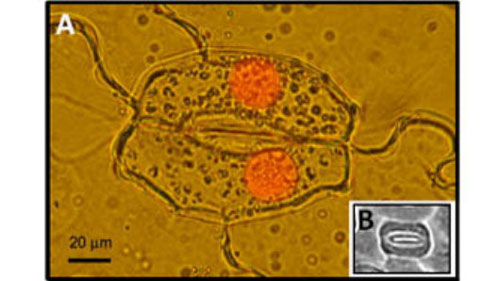| Oct 24, 2012 |
Genome evolution and carbon dioxide dynamics
|
|
(Nanowerk News) The total amount of DNA in the nucleus of an organism is known as the genome size. In plants this character varies nearly 2400-fold between species, with many having up to 50 times more DNA than is found in our own genome.
|
|
Fossil guard cells reveal genome size evolution
|
|
Understanding the biological significance of this variation has been an ongoing research theme at Kew for nearly 30 years. One area of focus has been the study of genome size evolution and great progress has been made by superimposing genome size data onto the phylogenetic trees of plants. Nevertheless, we have had no idea of how genome size has varied over geological time as it is impossible to measure this from fossils.
|
 |
| Impact of genome size on guard cell size. Paris japonica (A) and Quercus robur (B) differ 170-fold in genome size and this is reflected in the size of the guard cells. Both pictures are taken at the same magnification. (Image: Peter Franks)
|
|
Given that the size of genomes and guard cells (which form the stomata) are closely linked (see picture), researchers at the universities of Sheffield (UK) and Yale (USA), in collaboration with Kew scientists, used the size of fossil guard cells as a proxy for genome size to track how this has changed over the past 400 million years (spanning the full geological history of vascular plants). The results suggest that genome size evolution has been dynamic with both increases and decreases taking place during plant evolution.
|
|
Genome sizes correlate with carbon dioxide levels
|
|
Coupling this information with knowledge of how atmospheric carbon dioxide levels have fluctuated over the same time period revealed a good correlation between these parameters, with larger guard cells and inferred genome sizes found when levels of carbon dioxide were high. Of course, the observed correlation does not mean that carbon dioxide levels are directly driving changes in guard cell size and genome size. Nevertheless, because guard cells play a key role in optimising gas exchange in plants, the results hint at the possibility that carbon dioxide might be one of the selective forces responsible for generating the diversity of guard cell and genome sizes encountered in today’s flora.
|
|
Given that the particular genome size of a plant can have a considerable influence on where, when and how a plant lives, understanding the nature of the relationship between carbon dioxide levels and genome size will become increasingly important as the level of atmospheric carbon dioxide continues to rise.
|
|
Article References
|
|
Franks, P. J., Leitch, I. J., Ruszala,E. M., Hetherington, A. M. & Beerling, D. J. (2012). Physiological framework for adaptation of stomata to CO2 from glacial to future concentrations. Philosophical Transactions of the Royal Society B 367: 537-546.
|
|
Franks, P. J., Freckleton, R. P., Beaulieu, J. M., Leitch, I. J. & Beerling, D. L. (2012). Megacycles of atmospheric carbon dioxide concentration correlate with fossil plant genome size. Philosophical Transactions of the Royal Society B 367: 556-564
|

